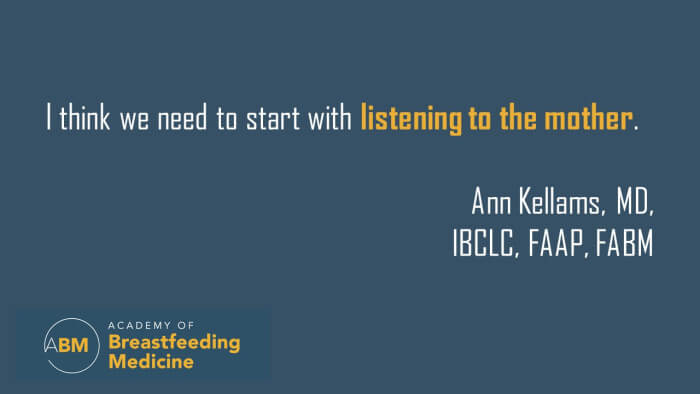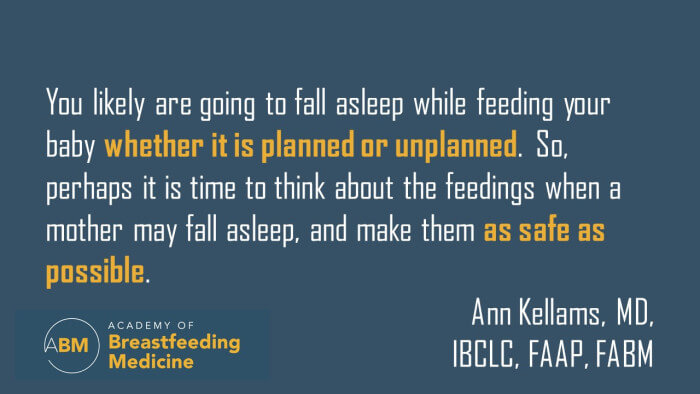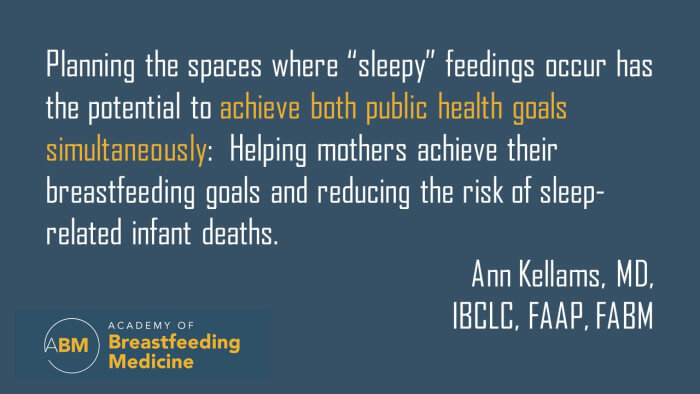Infant Care
Reality: New Moms Fall Asleep Feeding Their Babies
Where will you be when (not if) you fall asleep while feeding your baby?
Dr. Ann Kellams-breaks down the reality of feeding your baby at night, and how to prepare safe feeding spaces, in her blog written for the Academy of Breastfeeding Medicine.
Healthy newborns wake easily and often to feed, and a “good sleeper” in this age group is one that lets you know when he or she is hungry, is an efficient and effective feeder, and settles after the feeding and falls back asleep. Modern societal expectations often do not allow for or encourage new mothers to sleep during the 16-20 hours/day that a newborn sleeps. There is often housework, family and visitors, thank you notes, older siblings, and far too often at least in the U.S., an earlier-than-it-should-be return to work. The “village” that traditionally swooped in and surrounded the dyad with care and support is often spread across miles, even oceans, and these mothers, while still recovering from birth, are left alone as their partner returns to work. It is not surprising that new mothers find themselves exhausted and in “survival mode” during which time the recommendations that they have heard to feed a certain way or have the baby sleep a certain way may fly out the window as they desperately try to achieve a little more sleep. And even though they may or may not be planning to, mothers of newborns are falling asleep while feeding their babies.
In addition, depending on where they turn for information, the recommendations for infant feeding and safe sleep can be confusing and may appear to be at odds with one another. We know that mothers who bedshare with their infant breastfeed for longer. We also know that where babies start off the night is not always where they end up in the morning. We know that breastfeeding is protective against Sudden Infant Death Syndrome (SIDS), but also that bedsharing may pose a risk for a sleep-related infant death, particularly in the setting of other risk factors such as prenatal smoking, formula feeding, maternal substance use, sedating medications, maternal obesity, prematurity, and the presence of soft bedding in the sleep environment. Some organizations recommend bedsharing as a means of supporting breastfeeding and cite data about the physiologic patterns and postures of mothers and babies when they bedshare. Other recommendations focus on safe sleep and recommend breastfeeding as a strategy to reduce the risk of SIDS but recommend against bedsharing to avoid an unintended sleep-related death.

What then is a mother to do? And how as physicians should we counsel them? I think we need to start with listening to the mother. What is the current sleep arrangement and why? Is she aware of the recommendations? What are her goals? How old is her baby? Is she back at work or school? What other specific risk factors does she or her baby have? What kind of support does she have? Starting with listening can help the physician determine the level of risk given the particular situation and tailor the education and advice. Even the organizations that recommend no bedsharing recognize that mothers are at risk of falling asleep while feeding and that the safest place to fall asleep while feeding is an adult bed with a flat, firm mattress and no soft bedding, i.e. pillows, blankets, or comforters in the environment. The groups that advocate for bedsharing as a strategy for successful breastfeeding also caution about soft bedding, the gestational age of the infant, breastfeeding vs. formula feeding, the avoidance of smoking and sedating medications or substances, etc. In fact, all of the recommendations have more items in common than not.

Rather than talk about breastfeeding recommendations as something separate from safe sleep recommendations, I think we need to focus on “safe nighttime feeding spaces.” You likely are going to fall asleep while feeding your baby whether it is planned or unplanned. So, perhaps it is time to think about the feedings when a mother may fall asleep, and make them as safe as possible. Here is what that might look like: When thinking about falling asleep while feeding, think of the letter ‘F’: Infant is Face-up (or on the back); it is on a Flat, Firm adult mattress; the space is Free of any pillows, plush, or soft bedding or head covering; the infant is Feeding only breastmilk; the space is Free of anyone other than the mother; there is a “Fashioned” infant sleep space nearby where they baby can be returned after the feeding; the mother is “Fully-aware” meaning she is not under the influence of sedating medications or substances; the infant is Fully-vaccinated; and there is Fresh air, i.e. no risk of overheating and no tobacco smoke in the environment. Situations or conditions that should certainly be avoided during nighttime feedings are pillows, blankets, comforters, plush of any kind in the bed; being in a couch, sofa, or chair where the risk of suffocation and falling is greater; or bedsharing when the infant is sick or premature.

Planning the spaces where “sleepy” feedings occur has the potential to achieve both public health goals simultaneously: Helping mothers achieve their breastfeeding goals and reducing the risk of sleep-related infant deaths. Having non-judgmental conversations, acknowledging that mothers are likely to fall asleep while feeding, and talking about both breastfeeding and safe sleep together will ensure that physicians are able to give, and mothers are able to receive, clear messages that are tailored exactly for them and their circumstances.
Dr. Ann Kellams is Vice Chair of Clinical Affairs in the Department of Pediatrics at the University of Virginia who served for 12 years has served as Medical Director of Well Newborn service and helped found the UVA Breastfeeding Medicine program in 2011. She serves on the Virginia Department of Health Breastfeeding Advisory Committee and on the Board of the Academy of Breastfeeding Medicine, and is the immediate past-Chair of the U.S. Department of Agriculture National Advisory Council for Maternal, Fetal, and Infant Nutrition. Her research is in the area of prenatal education related to infant feeding, hospital breastfeeding support, and safe sleep practices with the SMART and SCHOOL grants funded by the NICHD. She is a scientific advisor for the Virginia Department of Health Breastfeeding Friendly Consortium that offers web-based CME and MOC.
Blog posts reflect the opinions of individual authors, not ABM as a whole.
References
AAP SIDS and Other Sleep-Related Infant Deaths: Updated 2016 Recommendations for a Safe Infant Sleeping Environment http://pediatrics.aappublications.org/content/138/5/e20162938
ABM Clinical Protocol #6: Guideline on Co-sleeping and Breastfeeding
La Leche League Sweet Sleep- Nighttime and Naptime Strategies for the Breastfeeding Family http://www.llli.org/sweetsleepbook/thesafesleepseven
Attachment Parenting Infant Sleep Safety Guidelines
http://www.attachmentparenting.org/pdfs/API_Infant_Sleep_Safety_Brochure.pdf
University of Notre Dame Mother-Baby Behavioral Sleep Laboratory Frequently Asked Questions https://cosleeping.nd.edu/frequently-asked-questions/


